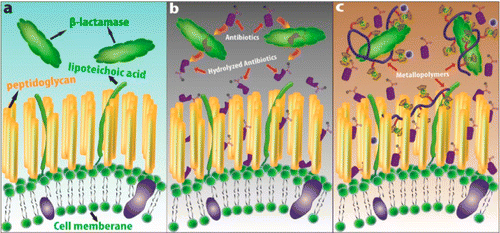Promising agents burst through 'superbug' defenses to fight antibiotic resistance

In the fight against "superbugs," scientists have discovered a class of agents that can make some of the most notorious strains vulnerable to the same antibiotics that they once handily shrugged off. The report on the promising agents called metallopolymers appears in the Journal of the American Chemical Society.
Chuanbing Tang and colleagues note that the antibiotic-resistant bacteria known as MRSA (methicillin-resistant Staphylococcus aureus) is responsible for a significant fraction of the infections that patients acquire in hospitals. According to the Centers for Disease Control and Prevention, MRSA usually spreads in hospitals when a health care provider with contaminated hands unknowingly passes it along to a patient. It can cause serious problems such as pneumonia, and can lead to death. One of the ways MRSA undermines conventional treatments is by producing enzymes that inactivate traditional antibiotics such as penicillin. Scientists have been developing new agents to combat these enzymes, but the agents so far have fallen short. Tang's team wanted to find a better alternative.
They tested a recently discovered class of metallopolymers—large, metal-containing molecules—against several strains of MRSA. When paired with the same antibiotics MRSA normally dispatches with ease, the polymer/antibiotic combo evaded the bacteria's defensive enzymes and destroyed its protective walls, causing the bacteria to burst. Also, the metallopolymers mostly left red blood cells alone, which suggests they might have minimal side effects. "These discoveries could pave a new platform to design antibiotics and antimicrobial agents to battle multidrug-resistant bacteria and superbugs," the researchers state.
More information: "Antimicrobial Metallopolymers and Their Bioconjugates with Conventional Antibiotics against Multidrug-Resistant Bacteria" J. Am. Chem. Soc., 2014, 136 (13), pp 4873–4876. DOI: 10.1021/ja5011338
Abstract
Bacteria are now becoming more resistant to most conventional antibiotics. Methicillin-resistant Staphylococcus aureus (MRSA), a complex of multidrug-resistant Gram-positive bacterial strains, has proven especially problematic in both hospital and community settings by deactivating conventional β-lactam antibiotics, including penicillins, cephalosporins, and carbapenems, through various mechanisms, resulting in increased mortality rates and hospitalization costs. Here we introduce a class of charged metallopolymers that exhibit synergistic effects against MRSA by efficiently inhibiting activity of β-lactamase and effectively lysing bacterial cells. Various conventional β-lactam antibiotics, including penicillin-G, amoxicillin, ampicillin, and cefazolin, are protected from β-lactamase hydrolysis via the formation of unique ion-pairs between their carboxylate anions and cationic cobaltocenium moieties. These discoveries could provide a new pathway for designing macromolecular scaffolds to regenerate vitality of conventional antibiotics to kill multidrug-resistant bacteria and superbugs.
Journal information: Journal of the American Chemical Society
Provided by American Chemical Society

















